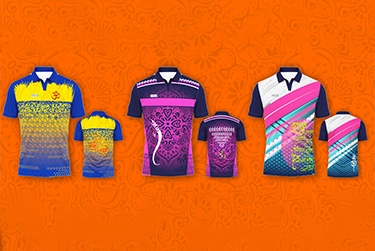Can color affect sporting performance? Sports fans know that donning their favorite team's colors sports Jersey isn't just about fashion—it's a powerful statement of loyalty, identity, connection, and, of course, a sense of unity. However, did you know that wearing team colours also have a significant psychological impact? Indeed, it does, profoundly affecting both performance and personal demeanor. Let's dive into the blog to decode the psychological effects of jersey colors on a sports team.

Influence of Colors on Performance and Perception
The significance of colour in sportswear layout extends beyond aesthetics, influencing an athlete's overall performance and perception on the field. Studies have shown that colors indeed have a psychological and physical impact on athletes. One of the most evident effects of wearing team colors is the surge in confidence.
In sports, wearing team colors can empower athletes, sharpening their focus and preparing them to tackle the competition easily. However, this doesn’t limit itself to athletes alone . Sports team fan followers wearing their favorite team's color often experience heightened optimism and confidence. Their body language and excitement soar, further energizing the team. Additionally, whether you're on the field or in the stands, customized sports jerseys act like armour, shielding you with your team's collective strength and spirit.
Choosing the Perfect Colors for Sportswear Design
Understanding color psychology in sportswear design enables athletes to select the appropriate hues to achieve their intended results. Athletes might obtain a competitive advantage by wearing colors that improve their confidence, increase their energy, or even terrify their opponents. The color-choosing process extends beyond personal taste or team identity; it should be consistent with the players' desired objectives and performance goals. First, assess the sport's demands.
Warm colors like red or orange increase aggression and intensity in high-intensity contact sports such as boxing or martial arts, providing participants with a psychological advantage. These hues can trigger the fight-or-flight response, increasing adrenaline and improving performance.
Cooler colors like green or blue can benefit games that require concentration and precision, such as golf or archery. These hues have a calming impact on athletes, allowing them to keep their composure and concentrate under pressure. They can also improve a harmonious and balanced environment that quickly boosts the team's performance.
Black symbolizes authority, power, and strength. Wear black sportswear could give the athletes an improved sense of assertiveness and authority, boosting their confidence and reassurance. It also could build a sleek and professional look that could intimidate their opponents and elevate overall performance.
Yellow has a positive meaning because it reflects light and brings out feelings of positivity, optimism, and happiness. Yellow sportswear can cultivate a bright and active environment, thus making an athlete feel more joyful and confident. It also can assist in creating a feeling of cohesion and teamwork among teammates, as yellow is regularly seen as a shade that promotes social interplay.
Furthermore, it is critical to consider the target audience and cultural connotations. Diverse hues may have diverse cultural significance. Understanding these associations can help athletes connect with their audience and make a lasting visual impression. Contact the best custom sublimated sportswear manufacturer if you want customized colors for your team.
Feeling Blue or Seeing Red: Emotional Associations with Colors
Colors effectively influence emotions and impact a person's mood, motivation, and perception. For instance, the color blue is regularly associated with feelings of calmness, serenity, and acceptance of truth. It can help athletes stay centered, maintain a sense of tranquility, and make strategic decisions on the field.
On the other hand, the color purple can evoke strong feelings, passion, strength, and even aggression. It has been observed to increase heart rate, blood pressure, and breathing rate, which can give athletes a surge of power and heightened competitiveness.
The Science Behind Color and Performance
Do you ever consider why some teams choose specific colors for their apparel?Surprisingly, there is a scientific explanation for this. Colors can influence how we view athletic performance. According to research, some colors can improve an athlete's perceived performance. Jersey colors can provide a psychological advantage by intimidating opponents and making the wearer appear firmer.
Harnessing the Psychology of Color for Sports Success
When it comes to athletic achievement, every benefit counts. Athletes and teams are constantly searching for opportunities to gain an advantage over their competitors, and the psychology of color in sportswear design presents a unique possibility to achieve that. Understanding the effect of color on perception and emotion allows sportswear designers to make uniforms that look good and contribute to improved overall performance on the field.
However, it isn't just about the color. Mix and contrast can also influence sportswear design. For example, deliberately using contrasting colors can improve an athlete's sight and reaction time, boosting overall performance and lowering the chance of injury.
Get Customized Sports Uniform Colors For Your Team's Success
The psychology of color in sportswear design extends beyond aesthetics. It can change perception, emotions, and an athlete's performance. By utilizing this knowledge in their designs, sportswear designers may assist athletes and teams in reaching their maximum potential on the field.
Noble Sportswear specializes in design and is India's best sportswear and activewear manufacturer. We offer solutions such as innovative design, extensive technical packing, exact color customization, and high-quality manufacture. Our knowledge assists brands in developing functional and long-lasting sportswear that satisfies the needs of a competitive market.


































